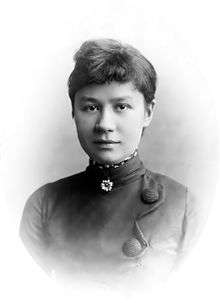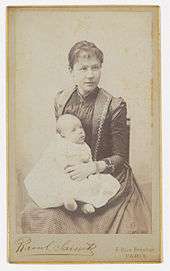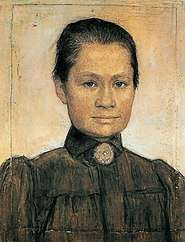Johanna van Gogh-Bonger
Johanna Gezina van Gogh-Bonger (4 October 1862 – 2 September 1925) was a Dutch editor and translator of the letters of the van Gogh brothers. She was the wife of Theo van Gogh, art dealer, and the sister-in-law of the painter Vincent van Gogh and became a key player in the growth of Vincent's fame.
Johanna van Gogh-Bonger | |
|---|---|
 Johanna van Gogh-Bonger in 1889 | |
| Born | Johanna Gezina Bonger 4 October 1862 Amsterdam, Netherlands |
| Died | 2 September 1925 (aged 62) Laren, Netherlands |
| Spouse(s) | |
| Children | Vincent Willem van Gogh |
Early life
Johanna Gezina Bonger was born on 4 October 1862 in Amsterdam in the Netherlands. She was the fifth of seven children, the daughter of Hendrik Christiaan Bonger (1828–1904), an insurance broker, and Hermine Louise Weissman (1831–1905). Her youngest brother, Willem Adriaan Bonger (1876–1940) became an important criminologist. The family was musical, holding evening performances of quartets, and Johanna became an accomplished piano player. Unlike her elder sisters, who helped out with household duties, Johanna, a "cheerful and lively child", was permitted to further her education by studying English, and earning the equivalent of a college degree. She stayed some months in London, working in the British Museum library.[1]
From the age of seventeen she kept a detailed diary, which was to become a source of much information about Vincent van Gogh. At this time she also came under the influence of the non-conformist writer Multatuli.
Adulthood

At the age of twenty-two she became a teacher of English at a boarding school for girls at Elburg, later teaching at the High School for Girls at Utrecht. About this time while in Amsterdam she was introduced by her brother Andries to Theo van Gogh, brother of Vincent. One of the Van Gogh sisters described her as "smart and tender".
First marriage
Theo became preoccupied with Johanna, and the following year paid a visit to Amsterdam to declare his love. Surprised and annoyed that a man she hardly knew should wish to marry her, she rejected him. However, she accepted his proposal the following year, and they were married in Amsterdam on 17 April 1889. Their son Vincent Willem, was born on 31 January 1890. Following Theo's death in January 1891, Johanna was left a widow with her infant son to support.
She was left with only an apartment in Paris filled with a few items of furniture and about 200 then valueless works of her brother-in-law Vincent.[2] Although advised to dispose of the pictures, she instead moved back to the Netherlands, opened a boarding house in Bussum, a village 25 km from Amsterdam, and began to re-establish her artistic contacts. She had not kept her diary during her marriage, but resumed it, intending that her son should read it someday. To earn extra income she translated short stories from French and English into Dutch. In 1905, to the evident disapproval of her family, she was one of the founding members of a women's socialist movement, but did not allow this to interfere with raising her son.
In 1892, while organizing an exhibition of Vincent's works, she was harshly criticized by artist Richard Roland Holst:
"Mrs Van Gogh is a charming little woman, but it irritates me when someone gushes fanatically on a subject she knows nothing about, and although blinded by sentimentality still thinks she is adopting a strictly critical attitude. It is schoolgirlish twaddle, nothing more. [...] The work that Mrs Van Gogh would like best is the one that was the most bombastic and sentimental, the one that made her shed the most tears; she forgets that her sorrow is turning Vincent into a god."[3]
Second marriage

In August 1901, she married Johan Cohen Gosschalk (1873–1912), a Dutch painter who was born in Amsterdam. She was widowed again in 1912. In 1914, she moved Theo's body from Utrecht to Auvers-sur-Oise and interred it next to Vincent's grave. A sprig of ivy taken from the garden of Dr Paul Gachet carpets both graves to this day.
Work and van Gogh letters
After the death of Vincent and her husband, she worked assiduously on editing the brothers' correspondence, producing the first volume in Dutch in 1914. She also played a key role in the growth of Vincent's fame and reputation through her donations of his work to various early retrospective exhibitions. She wrote a Van Gogh family history as well.[4]
Johanna van Gogh stayed in contact with Vincent van Gogh's friend Eugène Boch to whom she offered the painting portrait of Eugene Boch in July 1891.[5] She also stayed in touch with Émile Bernard, who helped her to promote Vincent van Gogh's paintings.
The legacy and renown of Vincent van Gogh the long-suffering artist began to spread in the years after his death; first in the Netherlands, and Germany and then throughout Europe. His friendship with his younger brother Theo was documented in numerous letters they exchanged from August 1872 onwards. Van Gogh-Bonger published the letters in three volumes in 1914. Johanna initially worked closely with German art dealers and publishers Paul Cassirer and his cousin Bruno to organize exhibitions of Van Gogh's paintings in Berlin and in 1914 to publish the first volume of the Letters to Theo. Publication of the letters helped spread the compelling mystique of Vincent van Gogh, the intense and dedicated painter who suffered for his art and died young, throughout Europe and the rest of the world.
Later life
She lived in New York from 1915 to 1919, where she began the work of translating Vincent's letters into English. In 1919, she returned to Amsterdam. She died on 2 September 1925, at the age of 62, in Laren, Netherlands. At the time of her death, she was still occupied translating 526 of Vincent's letters into English. She had one child and four grandchildren.
References
- Van Gogh: The Life. S Naifeh & G. White Smith. Profile Books (2012) p450
- Memoirs of V.W.Van Gogh http://www.webexhibits.org/vangogh/memoir/nephew/1.html
- Quoted in J.M. Joosten, "Van Gogh publicaties (15) deel 6", Museumjournaal 15 (1970), pp. 157-58, note 61.
- "Vincent van Gogh Memoir". Webexhibits.org. Retrieved June 3, 2011.
- "Johanna van Gogh stayed in touch with Eugene Boch". Eugeneboch.com. Archived from the original on 2011-07-10. Retrieved 2012-08-01.
External links
| Wikimedia Commons has media related to Johanna Bonger. |
- Glen, David A.; Havlicek, William J. (2020). "Johanna: The Other Van Gogh". Pegasus Media Solutions. Laguna Hills, CA: Creative Storytellers. ISBN 978-0-9824872-0-4. Archived from the original on 2018-07-25. Webpage announcing a biography of Johanna Bonger.
- Johanna van Gogh-Bonger's memoir
- Webexhibits online museum, Memoir by her son, W.V. van Gogh, edited and compiled by Robert Harrison.
- Archief Johanna G. van Gogh-Bonger at the International Institute of Social History